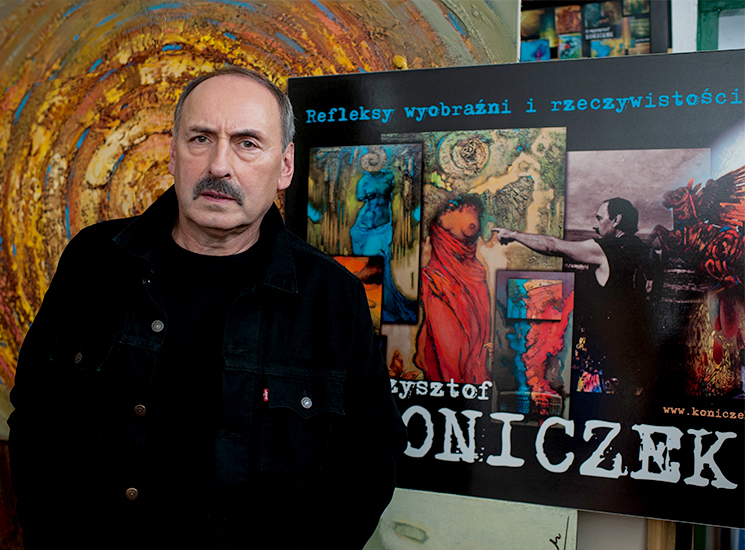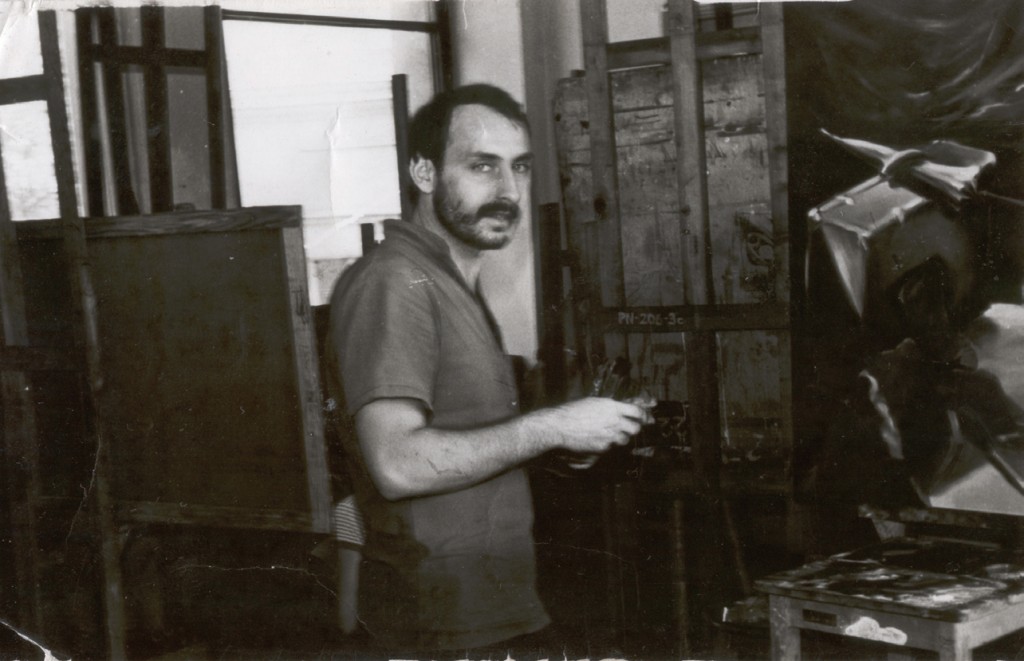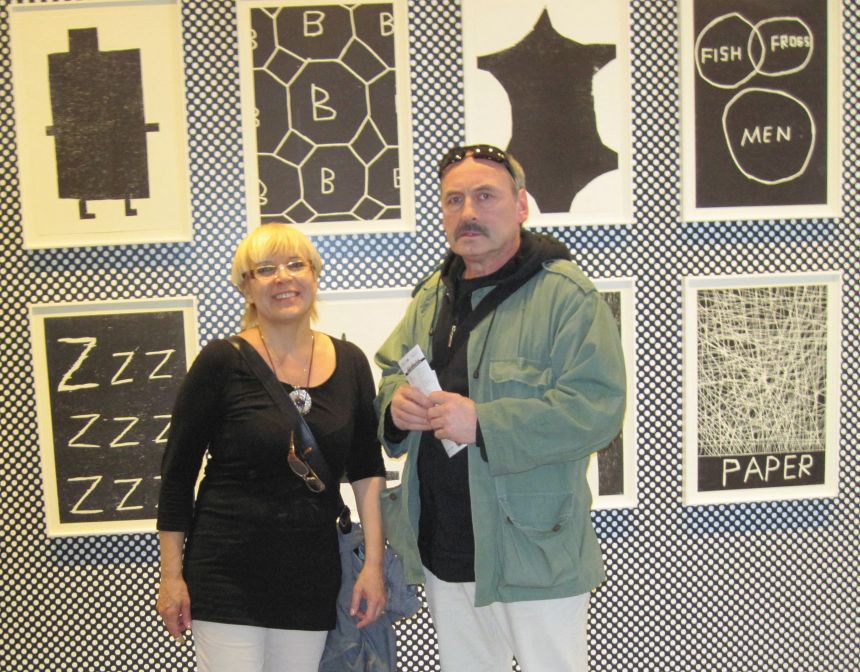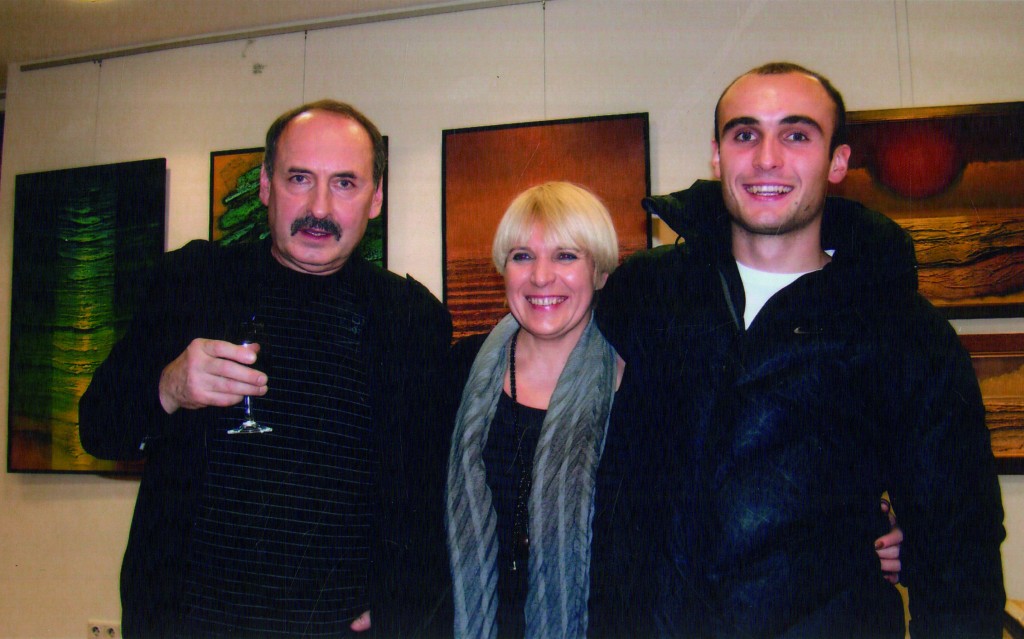Biografia
Biography
 Urodzony w 1955 roku w Olecku. Studia w Państwowej Wyższej Szkole Sztuk Plastycznych w Poznaniu, obecnie ASP na Wydziale Malarstwa,Grafiki i Rzeźby. Dyplom w pracowni prof. Waldemara Świerzego. Prace w zbiorach Muzeum Okręgowego, Muzeum Wojska w Białymstoku, ASTWA, NOT. Kolekcje prywatne: USA, Kanada, Niemcy,Szwecja, Włochy, Australia, Szwajcaria, Anglia,Francja, Polska, Hong-Kong. Malarstwo sztalugowe, ścienne, aranżacja wnętrz, plakat. Współpraca scenograficzna z Operą i Filharmonią Podlaską. 60 wystaw indywidualnych, ok. 70 wystaw zbiorowych,udział w Warszawskich Targach Sztuki oraz wielu aukcjach charytatywnych. Publikacjem.in. „Kto jest kim na Białostocczyźnie”, „MalarzePodlasia”, „Artyści Białegostoku XVIII- XXwiek”, „Who is Who w Polsce” wyd. IV, Album„Koniczek – obrazy – pictures”, album „Nowe Otwarcie” na 100-lecie ZPAP, album „Magia Obrazu I”, album „Magia Obrazu II” programy TV i radiowe.2012 – odznaczenie Ministra Kultury i Dziedzictwa Narodowego – Zasłużony Dla Kultury Polskiej.
Urodzony w 1955 roku w Olecku. Studia w Państwowej Wyższej Szkole Sztuk Plastycznych w Poznaniu, obecnie ASP na Wydziale Malarstwa,Grafiki i Rzeźby. Dyplom w pracowni prof. Waldemara Świerzego. Prace w zbiorach Muzeum Okręgowego, Muzeum Wojska w Białymstoku, ASTWA, NOT. Kolekcje prywatne: USA, Kanada, Niemcy,Szwecja, Włochy, Australia, Szwajcaria, Anglia,Francja, Polska, Hong-Kong. Malarstwo sztalugowe, ścienne, aranżacja wnętrz, plakat. Współpraca scenograficzna z Operą i Filharmonią Podlaską. 60 wystaw indywidualnych, ok. 70 wystaw zbiorowych,udział w Warszawskich Targach Sztuki oraz wielu aukcjach charytatywnych. Publikacjem.in. „Kto jest kim na Białostocczyźnie”, „MalarzePodlasia”, „Artyści Białegostoku XVIII- XXwiek”, „Who is Who w Polsce” wyd. IV, Album„Koniczek – obrazy – pictures”, album „Nowe Otwarcie” na 100-lecie ZPAP, album „Magia Obrazu I”, album „Magia Obrazu II” programy TV i radiowe.2012 – odznaczenie Ministra Kultury i Dziedzictwa Narodowego – Zasłużony Dla Kultury Polskiej.
He was born in 1955 in Olecko. Academy of Fine Arts in Poznan. Diploma in the prof. Waldemar Swierzy’s studio. The works in the Museum District and the Army Museum in Bialystok. Private Collections: USA, Canada, Germany, Sweden, Italy, Australia, Switzerland, England,France, Poland, Hong-Kong. Painting, wall, interior design, poster. 60 individual exhibitions, about 70 group exhibitions, participation in the Art Fair, and many charity auctions. Publications: „Who’s Who inthe Bialystok region,” „Painters of Podlasie”, „Artists of Bialystok XVIII-XX century”, „Whois Who in Poland” edition IV, Album „Koniczek- obrazy – pictures”, Album „Magic of Picture”, Album „Magic of Picture II”, „ New Opening” – 100 years ZPAP, dozens of TV shows and radioprograms. 2012 – medal Merit for Polish Culture.
 |
 |
| Jadwiga z domu Mickiewicz – mama
|
Antoni Koniczek – ojciec Animator kultury, twórca i realizator teatrów lalkowych i dramatycznych, uczestnik plenerów malarskich |
 |
 |
| … szkoła średnia
|
… studia ASP Poznań
|
 |
 |
|
… z żoną Małgorzatą w Museum of Modern Art,w Nowym Yorku |
… z żoną Małgorzatą i synem Tomkiem na wystawie na Uniwesrsytecie Medycznym w Białymstoku |
Krzysztof Koniczek
Pierwszą indywidualną wystawę miał w połowie lat 80. w czasie, gdymłodzi rzeczywiście byli gniewni, a to za sprawą kryzysu, zarówno europejskiej jak i amerykańskiej awangardy schyłku lat 70. Jeśli dodać,że towarzyszyło temu rozczarowanie polityką, socjotechniką i kulturąmasową, jasne stają się ówczesne poszukiwania nowej estetykii w ogóle innej postawy. Poszukiwania te przybrały tak radykalną postać, że krytyka nie cofnęła się przed nazwaniem skrajnie ekspresyjnych poczynań młodych twórców „agrafką w policzku współczesnej sztuki”. To był czas, w którym artysta wyrażał siebie i tylko siebie bezpośrednictwa racjonalizmu i logiki. Do lamusa odesłano wówczas wszystkie stare i nowe kanony Piękna, uprawiano punk-rock i reggae, a w galeriach królowali performerzy, nowi „dzicy” i video-art. Najwcześniejsze płótna Koniczka, to płaszczyzny ostentacyjnie lekceważące klasyczną kompozycję , w dodatku o kolorystyce budowanej na zderzeniach czerwieni z zielenią lub błękitu z oranżem. O takim malarstwie pisał Kasimir Edschmid w jednym z ważniejszych wyznań ekspresjonistów: „Ekspresjonista nie widzi lecz patrzy. On nie odnotowuje ale żyje. On nie reprodukuje ale tworzy. On nie selekcjonuje ale szuka.” Do pierwszej indywidualnej wystawy malarstwa Koniczka w Poznaniu doskonale przystaje prasowa wypowiedź Salome z roku 1980 – „Dla mnie nie jest to zagadnienie stylu lecz postawa życiowa. Jest to związane z uczuciem bycia wolnym,ze swobodną pracą…”W drugiej fazie twórczości – a jest to artysta pracujący dużo – Koniczek, nie rezygnując z malarstwa „pełnego farby i pędzla, wzbogaca je o myślenie właściwe plakatowi. Powstają wówczas płótna bardziej zorganizowane, mniej intuicyjne i spontaniczne ale zawsze bardzo ekspresyjne. Jest to ciągle i przede wszystkim ekspresja koloru odwołującego się do świata emocji. Jest to estetyka oparta na kontraście i to zarówno na kontraście tonów, nasycenia, jasności, jaki temperatury barwy. Malarz, świadom intensywności z jaką działa kolor, i to zarówno w sensie kulturowym jak i czysto fizycznym, świadom symboliki i psychologii postrzegania koloru, komponuje swoje płótna wokół podstawowej pary: czerwień-zieleń. Ten kontrast stanowi oś, wokół której pojawiają się zdecydowane, jak „wyciśnięte prosto z tuby” oranże, żółcie i błękity tworzące dialog często przechodzący w krzyk. Tak ekspresyjnemu kolorowi w sposób naturalny towarzyszy faktura płócien – chropowata, miejscami zbliżająca się do reliefu, w której zastygł ślad ręki malarza. Dukt pędzla, grudki farby, to wszystko jest widoczne w sposób czysto fizyczny ale jednocześnie są to smugi światła i żarzące się punkty, bo właśnie dzięki światłu te płótna w zadziwiający sposób są równocześnie materialne i metafizyczne.Większość płócien Koniczka to kompozycje abstrakcyjne, bo w takich niczym nie ograniczonych przestrzeniach znacznie swobodniej dokonuje się misterium koloru. Są to obrazy pulsujące energią wręcz wulkaniczną i nic dziwnego, że wiele z nich zdominował kolor płynącej lawy. Nie wyczerpuje to przecież do końca ani ciekawości malarza ani jego potrzeby drążenia zagadki form i tak w jego kompozycjach pojawia się kształt geometryczny i to w postaci kuli, najdoskonalszej z brył. W ten sposób, z przestrzeni szalonego koloru, malarz przenosi widza w przestrzeń kosmicznego ładu ale to nie jest kres podróży, bo oto kompozycja jego płócien najwyraźniej zaczyna przypominać pejzaż. Pierwsze doświadczenie to tajemniczy obraz pęknięcia w skalistym masywie ale już wkrótce pojawią się płótna wyraźnie nawiązujące do pejzaży Turnera, angielskiego romantyka pierwszej połowy XVIII w., którego najsłynniejszy obraz to „Pożar Parlamentu Brytyjskiego”. Skręt wydawać się może dziwny ale nie wtedy kiedy patrzy się na najnowsze obrazy Koniczka – to rzeczywiście konsekwentny i logiczny rozwój, bo w płótnach tego malarza, nawet tych najbardziej dzikich, zawsze można było wyczuć więź z naturą. Tak też było, kiedy malował zmysłowe akty, w których przewrotnie łączył marmurową piękność Wenus z Milo z wdziękiem striptizerki. Najnowsze płótna Koniczka to już wysmakowane kompozycje koloru i światła, to tajemnicze przestrzenie, cokolwiek nostalgiczne i skłaniające do refleksji, w których trzy czwarte zajmuje niebo niezwykłymi chmurami, a resztę stanowi wąski pas ziemi lub wody pięknie zaznaczonej refleksami słońca. W zestawieniu z wcześniejszymi obrazami uderza cisza i spokój tych płócien, choć w każdym z nich daje się wyczuć rodzaj oczekiwania – to pejzaże, w których wszystko może się zdarzyć. Na tym wszakże nie wyczerpuje się to co malarz ma do powiedzenia. Równolegle do tych harmonijnych, aczkolwiek zagadkowych pejzaży, Koniczek kontynuuje nurt ekspresyjnej abstrakcji i widz może oglądać jego niby drzewa, a więc formy bez wątpienia wywiedzione z natury.
Andrzej Koziara
Krzysztof Koniczek
He had his first individual exhibition in the middle of 1980s – at thetime when the young were really angry as the result of the crisis ofthe avant-garde from 1970s, both European and American. Whenwe add that it was accompanied by the disappointment with politics, sociotechnique and mass culture, the phenomena prevalentat that time, such as the search for new aesthetics and attitude ingeneral, become clear. That search appeared in such radical formthat the critics did not hesitate to call those extremely expressive actions of young artists ‘a safety-pin in the chick of modern art’. Thatwas the time when the artist expressed himself , and only himself, without the agency of rationalism and logic. All the old and newcanons of Beauty were discarded; punk rock and reggae were performed, and video art and performers, the new ‘wild’ ones, reignedin galleries. Koniczek’s earliest canvases were the planes ostentatiously neglectingthe classical composition, in addition with the colouring builtupon the clash of red and green or blue and orange. Kasimir Edschmidwrote about such painting in one of the most important confessionsof expressionists: ‘An expressionist does not see, but looks. He does not record, but lives. He does not reproduce, but creates. He does not select, but seeks ’Salome’s press comment from 1980also perfectly squares with Koniczek’s first individual exhibition inPoznań: ‘For me it is not a question of style, but the attitude to life. It is connected with the feeling of being free, with unconstrained work… ’In the second stage of his artistic activity, and he is artist who worksa lot, Koniczek, not resigning from the painting, ‘full of paint andbrush’, enriches it with the forms characteristic of the poster. At thattime he creates more organized, less intuitive and spontaneous canvases, nevertheless always very expressive. It is always, and aboveall, the expression of colour pertaining to the world of emotions. Itis the aesthetics based on contrast, the contrast of both the tones, saturation, brightness and the temperature of the colour. The painter, being aware of the intensity with which the colour operates, both in the cultural and the physiologic sense, aware of thesymbolic nature and the psychology of the perception of colour, composes his canvases around the basic pair: red and green. Thiscontrast forms an axle around which conspicuous colours appear, such as ‘squeezed out of a tube’ orange, yellow, blue, which form adialog, often changing into a shout. Such an expressive colour is ina natural way accompanied by the texture of the canvases: rough, sometimes approximating a relief in which the trace of the master’shand has been impressed. The mark of a brush, the lumps of paint,all this is visible in a purely physical way, but on the other hand, there are the trails of light and some glowing points, because it isdue to the light that these canvases are amazingly both materialand metaphysical. Most of Koniczek’s canvases are abstract compositions, because insuch unlimited space the mystery of colour may be accomplished much easier. These were the paintings pulsating with just volcanic energy, and it is no wonder that many of them are dominated bythe colour of flowing lava. Yet, it does exhaust to the end neitherthe painter’s curiosity nor his need to dwelling in the mystery offorms. Therefore, the geometric shape appears in his compositions, what is more in the form of the sphere – the most perfect one ofall. In this way the painter transfers the viewer from the space ofthe mad colour into a space of the cosmic order, but this is not theend of the journey because the composition of his canvases clearlybegins to resemble a landscape. The first experience is the mysterious sight of a fracture in a rockymassif , but soon there appear canvases clearly referring to Turner’slandscapes, a romantic painter from the first half of the 17th century, whose most famous painting is : ‘The Fire of the British Parliament’. The turn may seem to be strange, but not when we look atthe latest paintings by Koniczek: it is really a consistent and logical development, as in the painter’s canvases, even the wildest ones,we have always been able to feel the bond with the nature. It was also the case when he painted the sensual nudes, where he perversely combined the marble beauty of the Venus from Milo with astripper’s charm. Koniczek’s latest canvases are tasteful compositions of colour and light, a little nostalgic mysterious expanses inducing to reflection,where three fourths of the canvas are occupied by the sky with unusual clouds, and the rest is a narrow strip of earth or water, beautifully marked with sun reflexes. In comparison with the earlier paintings they strike us with their peace and quiet, though in eachof them we can sense a kind of awaiting. They are landscapes in which everything may happen. Stating all that, we cannot exhaust the topic at that point: the painterhas a lot to say. Simultaneously to those harmonic, though mysterious landscapes, Koniczek continues with the trend of expressive abstraction, and the viewer may watch his quasi-trees, formsundoubtedly taken from the nature.
Andrzej Koziara
